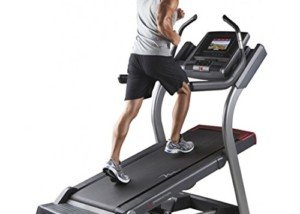Are you so overweight that you’re reluctant to take up cardio exercise because you believe your size will interfere with getting any results?
Performance isn’t what gets results; effort is. Very high effort levels are possible with the obese body. Do not confuse performance with effort.
This isn’t about expecting a very overweight man to sprint around a track like a greyhound.
It’s about putting his body through a routine that drains him in a feel-good way, even if it’s jogging only 3 mph.
He may have to breathe very fast and hard, and sweat buckets to sustain this slow speed, but this is high effort for this particular body.
When Cardio Exercise Is Too Uncomfortable
It’s supposed to be if you want it to force your body to make adaptations – whether you want to lose 100 pounds, 20 pounds or have a healthy cardiovascular system.
Trainers are faced with sad-eyed clients who report that cardio workouts are just too uncomfortable, and that it’s far more tolerable to just slowly walk around the track or easily pedal on the bike.
- What does “uncomfortable” mean to you, the overweight man or woman?
- Does it mean knee pain every time you try to jog or pedal on a machine?
- Does it mean a lot of sweat?
- Does it mean heavy breathing?
- Does it mean the feeling you get when trying to move your body faster than what it’s used to?
A fitter, trimmer body is not created by comfortable exercise. It’s also not created by painful exercise, either.
When working out, no matter how tough the routine is, you should not be having pain in your joints, back pain, headaches, nausea or the feeling that a hamstring muscle is about to snap.
If you can exercise without any of these issues, then you have no excuses, even if very overweight.
Performance vs. Effort in Aerobic Exercise

Shutterstock/New Africa
Performance is an objective metric, such as speed, grade of incline, how much time it took to complete a routine, number of pedal revolutions, level of pedal or step resistance, height of a stepping platform, etc.
Effort is a subjective value that’s indicated by how one feels during the exercise – regardless of an objective metric.
If an overweight person feels she’s kicking her butt while jogging 2.5 mph on a 5% incline (no holding onto the machine!), then her sense of effort – or rate of perceived exertion – is very real.
She’s putting in a high effort that’s reflected also in her heart rate and respiration (very elevated).
So though the performance is low (very slow speed for jogging), her effort level is high because she’s sticking out an activity that feels grueling and makes it impossible to converse with the person on the next treadmill.
The person on the next treadmill has decided to hum to the song she’s listening to on her headset, because she’s warming up for her workout.
Her warmup consists of jogging at 2.5 mph on a 5% incline. She’s able to comfortably breathe with her mouth closed – and has no problem humming during this very easy activity.
Her effort level is minimal. She then ramps up the intensity to 7 mph at the 5% incline.
She’s soon breathing hard and can no longer hum; she can’t even carry on a conversation but is able to maintain the fast speed.
Her effort level is high – but – relative to the overweight woman next to her, her performance is also high.
A third individual gets on the next treadmill and warms up at 7 mph and 5% incline.
For this person, this is low effort. She then ramps up to 10 mph and maintains this, heart and respiration quite elevated.
So you see, effort level is subjective, and performance level can be relative.
But you should also clearly see that being very overweight is not an obstacle to a high effort level.
Never mind that the woman next to you did a warmup that’s your working speed.
There’ll always be someone who’s faster and fitter than the next person (until you get to the Olympic level; nobody thus far is faster than Usain Bolt or Michael Phelps).
Use Effort Level As Your Barometer
Don’t get overly fixated on speed, inclines or pedal resistance. Instead, focus on effort: how your body feels.
If it feels worked over from your exercise, or if during the activity you felt your butt getting kicked, then consider this a successful session.
Even if the speed is 2 mph or it took you 20 minutes to jog one mile.
“Overly fixated” is the key term. It’s perfectly okay to be mindful of objective metrics, as this can be powerfully motivating to make improvements.
For instance, it’s exciting to see that you can now jog a mile in 18 minutes, or complete a particular group fitness class without taking more than one break.
Objective metrics yield objective improvements. It’s very gratifying to know that today, your body cruised through something that it struggled with eight weeks ago – as indicated by the metric of speed, time, incline or pedal revolution, etc.
In summary, don’t ever let your size convince you that you “can’t do” aerobic activity. Unless you’re confined to a bed, you are fully capable of cardio exercise.










































